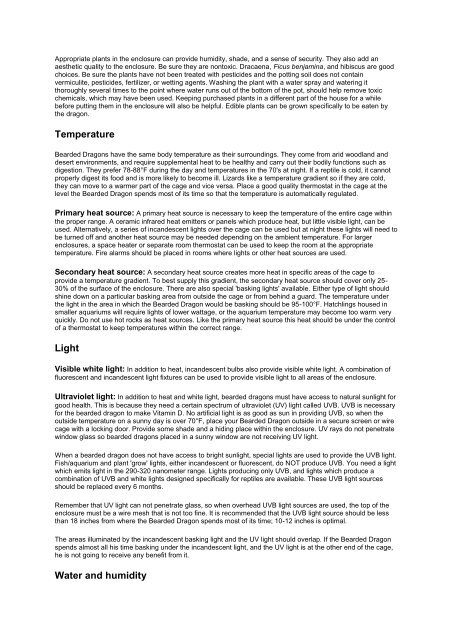Bearded Dragon Care Sheet - Shires Veterinary Practice
Bearded Dragon Care Sheet - Shires Veterinary Practice
Bearded Dragon Care Sheet - Shires Veterinary Practice
Create successful ePaper yourself
Turn your PDF publications into a flip-book with our unique Google optimized e-Paper software.
Appropriate plants in the enclosure can provide humidity, shade, and a sense of security. They also add an<br />
aesthetic quality to the enclosure. Be sure they are nontoxic. Dracaena, Ficus benjamina, and hibiscus are good<br />
choices. Be sure the plants have not been treated with pesticides and the potting soil does not contain<br />
vermiculite, pesticides, fertilizer, or wetting agents. Washing the plant with a water spray and watering it<br />
thoroughly several times to the point where water runs out of the bottom of the pot, should help remove toxic<br />
chemicals, which may have been used. Keeping purchased plants in a different part of the house for a while<br />
before putting them in the enclosure will also be helpful. Edible plants can be grown specifically to be eaten by<br />
the dragon.<br />
Temperature<br />
<strong>Bearded</strong> <strong>Dragon</strong>s have the same body temperature as their surroundings. They come from arid woodland and<br />
desert environments, and require supplemental heat to be healthy and carry out their bodily functions such as<br />
digestion. They prefer 78-88°F during the day and temperatures in the 70's at night. If a reptile is cold, it cannot<br />
properly digest its food and is more likely to become ill. Lizards like a temperature gradient so if they are cold,<br />
they can move to a warmer part of the cage and vice versa. Place a good quality thermostat in the cage at the<br />
level the <strong>Bearded</strong> <strong>Dragon</strong> spends most of its time so that the temperature is automatically regulated.<br />
Primary heat source: A primary heat source is necessary to keep the temperature of the entire cage within<br />
the proper range. A ceramic infrared heat emitters or panels which produce heat, but little visible light, can be<br />
used. Alternatively, a series of incandescent lights over the cage can be used but at night these lights will need to<br />
be turned off and another heat source may be needed depending on the ambient temperature. For larger<br />
enclosures, a space heater or separate room thermostat can be used to keep the room at the appropriate<br />
temperature. Fire alarms should be placed in rooms where lights or other heat sources are used.<br />
Secondary heat source: A secondary heat source creates more heat in specific areas of the cage to<br />
provide a temperature gradient. To best supply this gradient, the secondary heat source should cover only 25-<br />
30% of the surface of the enclosure. There are also special 'basking lights' available. Either type of light should<br />
shine down on a particular basking area from outside the cage or from behind a guard. The temperature under<br />
the light in the area in which the <strong>Bearded</strong> <strong>Dragon</strong> would be basking should be 95-100°F. Hatchlings housed in<br />
smaller aquariums will require lights of lower wattage, or the aquarium temperature may become too warm very<br />
quickly. Do not use hot rocks as heat sources. Like the primary heat source this heat should be under the control<br />
of a thermostat to keep temperatures within the correct range.<br />
Light<br />
Visible white light: In addition to heat, incandescent bulbs also provide visible white light. A combination of<br />
fluorescent and incandescent light fixtures can be used to provide visible light to all areas of the enclosure.<br />
Ultraviolet light: In addition to heat and white light, bearded dragons must have access to natural sunlight for<br />
good health. This is because they need a certain spectrum of ultraviolet (UV) light called UVB. UVB is necessary<br />
for the bearded dragon to make Vitamin D. No artificial light is as good as sun in providing UVB, so when the<br />
outside temperature on a sunny day is over 70°F, place your <strong>Bearded</strong> <strong>Dragon</strong> outside in a secure screen or wire<br />
cage with a locking door. Provide some shade and a hiding place within the enclosure. UV rays do not penetrate<br />
window glass so bearded dragons placed in a sunny window are not receiving UV light.<br />
When a bearded dragon does not have access to bright sunlight, special lights are used to provide the UVB light.<br />
Fish/aquarium and plant 'grow' lights, either incandescent or fluorescent, do NOT produce UVB. You need a light<br />
which emits light in the 290-320 nanometer range. Lights producing only UVB, and lights which produce a<br />
combination of UVB and white lights designed specifically for reptiles are available. These UVB light sources<br />
should be replaced every 6 months.<br />
Remember that UV light can not penetrate glass, so when overhead UVB light sources are used, the top of the<br />
enclosure must be a wire mesh that is not too fine. It is recommended that the UVB light source should be less<br />
than 18 inches from where the <strong>Bearded</strong> <strong>Dragon</strong> spends most of its time; 10-12 inches is optimal.<br />
The areas illuminated by the incandescent basking light and the UV light should overlap. If the <strong>Bearded</strong> <strong>Dragon</strong><br />
spends almost all his time basking under the incandescent light, and the UV light is at the other end of the cage,<br />
he is not going to receive any benefit from it.<br />
Water and humidity


